Rapid Earthquake Damage Assessment System in the Black Sea Basin: Selection/Adoption of Ground Motion Prediction Equations with Emphasis in the Cross-Border Areas
Abstract
:1. Introduction
2. Selection and Ranking of GMPEs for CBAs of Greece and Turkey
- (a)
- Normalized Residuals Method
- (b) Log-Likelihood method
- (c) Final Selection of GMPEs for Greece–Turkey CBA
3. GMPE Selection and Ranking for the Western Black Sea CBA—Romania, Moldova, and Bulgaria
3.1. Available Ground Motion Data
3.2. Selection of the GMPEs for Intermediate-Depth Vrancea Source
3.3. Selection of the GMPEs for Crustal Seismicity
3.4. Final Selections of the GMPEs
4. Discussion and Conclusions
Author Contributions
Funding
Data Availability Statement
Acknowledgments
Conflicts of Interest
References
- Papatheodorou, K.; Theodoulidis, N.; Klimis, N.; Zulfikar, C.; Vintila, D.; Cardanet, V.; Kirtas, E.; Toma-Danila, D.; Margaris, B.; Fahjan, Y.; et al. Rapid Earthquake Damage Assessment and Education to Improve Earthquake Response Efficiency and Community Resilience. Sustainability 2023, 15, 16603. [Google Scholar] [CrossRef]
- Douglas, J. Ground Motion Prediction Equations 1964–2020. 2021. Available online: http://www.gmpe.org.uk (accessed on 28 February 2024).
- Delavaud, E.; Cotton, F.; Akkar, S.; Scherbaum, F.; Danciu, L.; Beauval, C.; Drouet, S.; Douglas, J.; Basili, R.; Abdullah-Sandikkaya, M.; et al. Toward a ground-motion logic tree for probabilistic seismic hazard assessment in Europe. J. Seismol. 2012, 16, 451–473. [Google Scholar] [CrossRef]
- Woessner, J.; Laurentiu, D.; Giardini, D.; The SHARE Consortium. The 2013 European Seismic Hazard Model: Key components and results. Bull. Earthq. Eng. 2015, 13, 3553–3596. [Google Scholar] [CrossRef]
- REDACt Project. Ground Motion Prediction Equations and Seismic Sources Selection & Evaluation in the REDAS Pilot Investigation Areas Deliverable No: D.T3.1.1; REDACt Project Deliverable, 2021; 50p. Available online: https://app.box.com/file/926220681808 (accessed on 28 February 2024).
- Cotton, F.; Scherbaum, F.; Bommer, J.J.; Bungum, H. Criteria for selecting and adjusting ground motion models for specific target regions: Application to Central Europe and Rock Sites. J. Seismol. 2006, 10, 137–156. [Google Scholar] [CrossRef]
- Bommer, J.J.; Douglas, J.; Scherbaum, F.; Cotton, F.; Bungum, H.; Fah, D. On the selection of ground motion prediction equations for seismic hazard analysis. Seism. Res. Lett. 2010, 81, 783–793. [Google Scholar] [CrossRef]
- Akkar, S.; Sandıkkaya, M.A.; Bommer, J.J. Empirical ground-motion models for point-and extended-source crustal earthquake scenarios in Europe and the Middle East. Bull. Earthq. Eng. 2014, 12, 359–387. [Google Scholar] [CrossRef]
- Chiou, B.S.J.; Youngs, R.R. NGA model for the average horizontal component of peak ground motion and response spectra. Earthq. Spectra 2014, 30, 1117–1153. [Google Scholar] [CrossRef]
- Abrahamson, N.A.; Silva, W.J.; Kamai, R. Summary of the ASK14 ground motion relation for active crustal regions. Earthq. Spectra 2014, 30, 1025–1055. [Google Scholar] [CrossRef]
- Chousianitis, K.; Del Gaudio, V.; Pierri, P.; Tselentis, G.A. Regional ground-motion prediction equations for amplitude-, frequency response-, and duration-based parameters for Greece. Earthq. Eng. Struct. Dyn. 2018, 47, 2252–2274. [Google Scholar] [CrossRef]
- Kotha, S.R.; Weatherill, G.; Bindi, D.; Cotton, F. A regionally-adaptable ground-motion model for shallow crustal earthquakes in Europe. Bull. Earthq. Eng. 2020, 18, 4091–4125. [Google Scholar] [CrossRef]
- Boore, D.; Stewart, J.P.; Skarlatoudis, A.; Seyhan, E.; Margaris, B.; Theodoulidis, N.; Scordilis, E.; Kalogeras, I.; Klimis, N.; Melis, N. A Ground-Motion Prediction Model for Shallow Crustal Earthquakes in Greece. Bull. Seism. Soc. Am. 2021, 111, 857–874. [Google Scholar] [CrossRef]
- Davis, J. Statistics and Data Analysis in Geology, 3rd ed.; John Wiley & Sons: Hoboken, NJ, USA, 2002; 638p. [Google Scholar]
- Boos, D.; Stefanski, L.A. Likelihood Construction and Estimation. In Essential Statistical Inference: Theory and Methods; Springer: New York, NY, USA, 2013; pp. 27–124. [Google Scholar] [CrossRef]
- Edwards, A.W.F. Likelihood, Expanded; Johns Hopkins University Press: Baltimore, MD, USA, 1992; ISBN 13: 9780801844454. [Google Scholar]
- Scherbaum, F.; Cotton, F.; Smit, P. On the use of response spectral-reference data for the selection and ranking of ground-motion models for seismic-hazard analysis in regions of moderate seismicity: The case of rock motion. Bull. Seism. Soc. Am. 2004, 94, 2164–2185. [Google Scholar] [CrossRef]
- Scherbaum, F.; Delavaud, E.; Riggelsen, C. Model selection in seismic hazard analysis: An information-theoretic perspective. Bull. Seism. Soc. Am. 2009, 99, 3234–3247. [Google Scholar] [CrossRef]
- Ferrand, T.P.; Manea, E.F. Dehydration-induced earthquakes identified in a subducted oceanic slab beneath Vrancea, Romania. Sci. Rep. 2021, 11, 10315. [Google Scholar] [CrossRef] [PubMed]
- Craiu, A.; Ferrand, T.P.; Manea, E.F.; Vrijmoed, J.C.; Mărmureanu, A. A switch from horizontal compression to vertical extension in the Vrancea slab explained by the volume reduction of serpentine dehydration. Sci. Rep. 2022, 12, 22320. [Google Scholar] [CrossRef]
- Cioflan, C.O.; Toma-Danila, D.; Manea, E.F. Seismic loss estimates for scenarios of the 1940 Vrancea earthquake. In The 1940 Vrancea Earthquake. Issues, Insights and Lessons Learnt: Proceedings of the Symposium Commemorating 75 Years from 10 November 1940 Vrancea Earthquake; Springer International Publishing: Berlin/Heidelberg, Germany, 2016; pp. 425–439. [Google Scholar]
- Marmureanu, G.; Cioflan, C.O.; Marmureanu, A.; Manea, E.F. Main Characteristics of November 10, 1940 Strong Vrancea Earthquake in Seismological and Physics of Earthquake Terms. In The 1940 Vrancea Earthquake. Issues, Insights and Lessons Learnt; Springer: Cham, Switzerland, 2016; pp. 73–83. [Google Scholar]
- Constantin, A.P.; Pantea, A.; Stoica, R. Vrancea (Romania) Subcrustal Earthquakes: Historical Sources and Macroseismic Intensity Assessment. Rom. J. Phys. 2011, 56, 813–826. [Google Scholar]
- Manea, E.F.; Cioflan, C.O.; Danciu, L. Ground-motion models for Vrancea intermediate-depth earthquakes. Earthq. Spectra 2022, 38, 407–431. [Google Scholar] [CrossRef]
- Manea, E.F.; Danciu, L.; Manea, L.; Cioflan, C.O.; Ionescu, C. Exploratory Analysis of New GMPE’s Using Small/Moderate Crustal Events in Romania; PSHA Workshop: Lenzburg, Switzerland, 2017. [Google Scholar]
- Cioflan, C.O.; Manea, E.F. Advanced seismic input for risk analyses. In Multidisciplinary Research on Earthquake Monitoring and Seismic Modeling: Creator Program; Ionescu, C., Radulian, M., Bălă, A., Eds.; Romanian Academy: Bucharest, Romania, 2021; pp. 361–388. (In Romanian) [Google Scholar]
- INCDFP/NIEP (National Institute for Earth Physics, Romania). ROMPLUS Earthquake Catalogue. 2021. Available online: http://www.infp.ro/index.php?i=romplus (accessed on 28 February 2024).
- BIGSEES Project. Results. 2017. Available online: http://bigsees.infp.ro/Results.html (accessed on 28 February 2024).
- Radulian, M.; Bala, A.; Ardeleanu, L.; Toma-Danila, D.; Petrescu, L.; Popescu, E. Revised catalogue of earthquake mechanisms for the events occurred in Romania until the end of 20th century: REFMC. Acta Geod. Geophys. 2019, 54, 3–18. [Google Scholar] [CrossRef]
- Craiu, A.; Diaconescu, M.; Craiu, M.; Marmureanu, A.; Ardeleanu, L. The seismic sequence of the moderate-size crustal earthquake of 22 November 2014 of Vrancea region: Focal mechanism. In Proceedings of the 16th International Conference Multidisciplinary Scientific GeoConference SGEM 2016, Albena, Bulgaria, 30 June–6 July 2016; Book 1. Volume 3. [Google Scholar]
- Craiu, A.; Craiu, M.; Diaconescu, M.; Marmureanu, A. 2013 Seismic swarm recorded in Galati area, Romania: Focal mechanism solutions. Acta Geod. Et Geophys. 2017, 52, 53–67. [Google Scholar] [CrossRef]
- Manea, E.F.; Predoiu, A.; Cioflan, C.O.; Diaconescu, M. Interpretation of resonance fundamental frequency for Moldavian and Scythian platforms. Rom. Rep. Phys. 2019, 71, 709. [Google Scholar]
- Coman, A.; Manea, E.F.; Cioflan, C.O.; Radulian, M. Interpreting the fundamental frequency of resonance for Transylvanian Basin. Rom. J. Phys. 2020, 65, 809. [Google Scholar]
- Cioflan, C.O.; Manea, E.F.; Danciu, L.; Coman, A.; Mărmureanu, A. Evaluation of up-to-date ground motion models for inslab earthquakes in Romania. In Proceedings of the Geoscience International Symposium, Bucharest, Romania, 20–21 November 2020. [Google Scholar]
- Atkinson, G.M.; Boore, D.M. Empirical ground-motion relations for subduction-zone earthquakes and their application to Cascadia and other regions. BSSA 2003, 93, 1703–1729. [Google Scholar] [CrossRef]
- García, D.; Singh, S.K.; Herráiz, M.; Ordaz, M.; Pacheco, J.F. Inslab earthquakes of central Mexico: Peak ground-motion parameters and response spectra. BSSA 2005, 95, 2272–2282. [Google Scholar] [CrossRef]
- Lin, P.S.; Lee, C.T. Ground-motion attenuation relationships for subduction-zone earthquakes in northeastern Taiwan. BSSA 2008, 98, 220–240. [Google Scholar] [CrossRef]
- Sokolov, V.; Bonjer, K.P.; Wenzel, F.; Grecu, B.; Radulian, M. Ground-motion prediction equations for the intermediate depth Vrancea (Romania) earthquakes. Bull. Earthq. Eng. 2008, 6, 367–388. [Google Scholar] [CrossRef]
- Vacareanu, R.; Radulian, M.; Iancovici, M.; Pavel, F.; Neagu, C. Fore-arc and back-arc ground motion prediction model for Vrancea intermediate depth seismic source. J. Earthq. Eng. 2015, 19, 535–562. [Google Scholar] [CrossRef]
- Abrahamson, N.; Gregor, N.; Addo, K. BC Hydro ground motion prediction equations for subduction earthquakes. Earthq. Spectra 2016, 32, 23–44. [Google Scholar] [CrossRef]
- Bindi, D.; Massa, M.; Luzi, L.; Ameri, G.; Pacor, F.; Puglia, R.; Augliera, P. Pan-European ground-motion prediction equations for the average horizontal component of PGA, PGV, and 5%-damped PSA at spectral periods up to 3.0 s using the RESORCE dataset. Bull. Earthq. Eng. 2014, 12, 391–443. [Google Scholar] [CrossRef]
- Boore, D.M.; Stewart, J.P.; Seyhan, E.; Atkinson, G.M. NGA-West2 equations for predicting PGA, PGV, and 5% damped PSA for shallow crustal earthquakes. Earthq. Spectra 2014, 30, 1057–1085. [Google Scholar] [CrossRef]
- Cauzzi, C.; Edwards, B.; Fäh, D.; Clinton, J.; Wiemer, S.; Kästli, P.; Giardini, D. New predictive equations and site amplification estimates for the next-generation Swiss ShakeMaps. Geophys. J. Int. 2014, 200, 421–438. [Google Scholar] [CrossRef]
- Kale, Ö.; Akkar, S.; Ansari, A.; Hamzehloo, H. A ground-motion predictive model for Iran and Turkey for horizontal PGA, PGV, and 5% damped response spectrum: Investigation of possible regional effects. Bull. Seism. Soc. Am. 2015, 105, 963–980. [Google Scholar] [CrossRef]
- Solakov, D.; Simeonova, S.; Raykova, P.; Rangelov, B.; Ionescu, C. Earthquake Scenarios for the City of Ruse. In Proceedings of the 1st International Conference on Environmental Protection and Disaster RISKs, Sofia, Bulgaria, 29–30 September 2020; pp. 371–380. [Google Scholar] [CrossRef]
- Zafarani, H.; Luzi, L.; Lanzano, G.; Soghrat, M.R. Empirical equations for the prediction of PGA and pseudo spectral accelerations using Iranian strong motion data. J. Seismol. 2018, 22, 263–285. [Google Scholar] [CrossRef]
- Farajpour, Z.; Kowsari, M.; Pezeshk, S.; Halldorsson, B. Ranking of Ground-Motion Models (GMMs) for Use in Probabilistic Seismic Hazard Analysis for Iran Based on an Independent Data Set. Bull. Seism. Soc. Am. 2020, 111, 242–257. [Google Scholar] [CrossRef]
- Darzi, A.; Zolfaghari, M.R.; Cauzzi, C.; Fäh, D. An Empirical Ground-Motion Model for Horizontal PGV, PGA, and 5% Damped Elastic Response Spectra (0.01–10 s) in Iran. Bull. Seism. Soc. Am. 2019, 109, 1041–1057. [Google Scholar] [CrossRef]
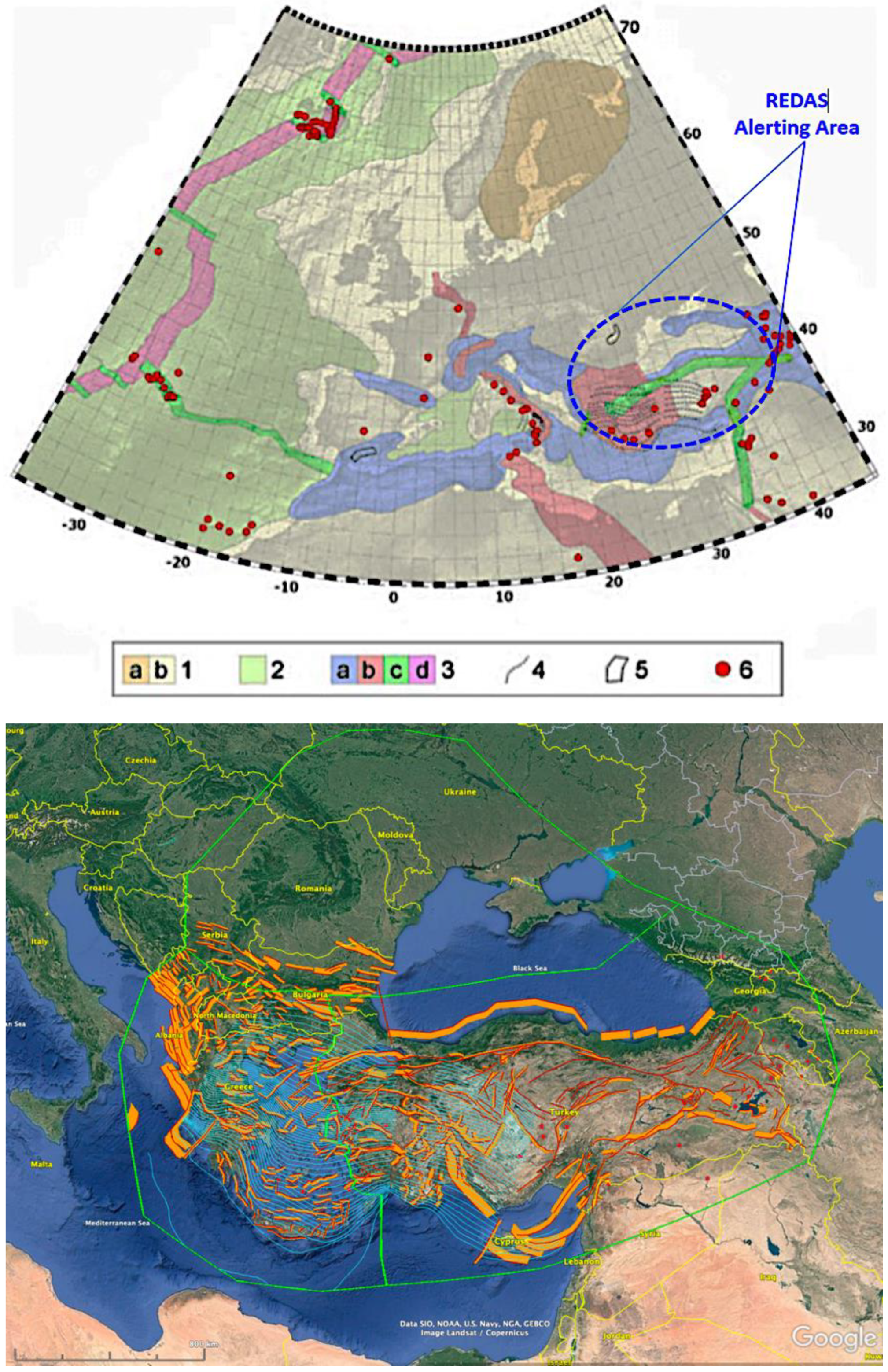
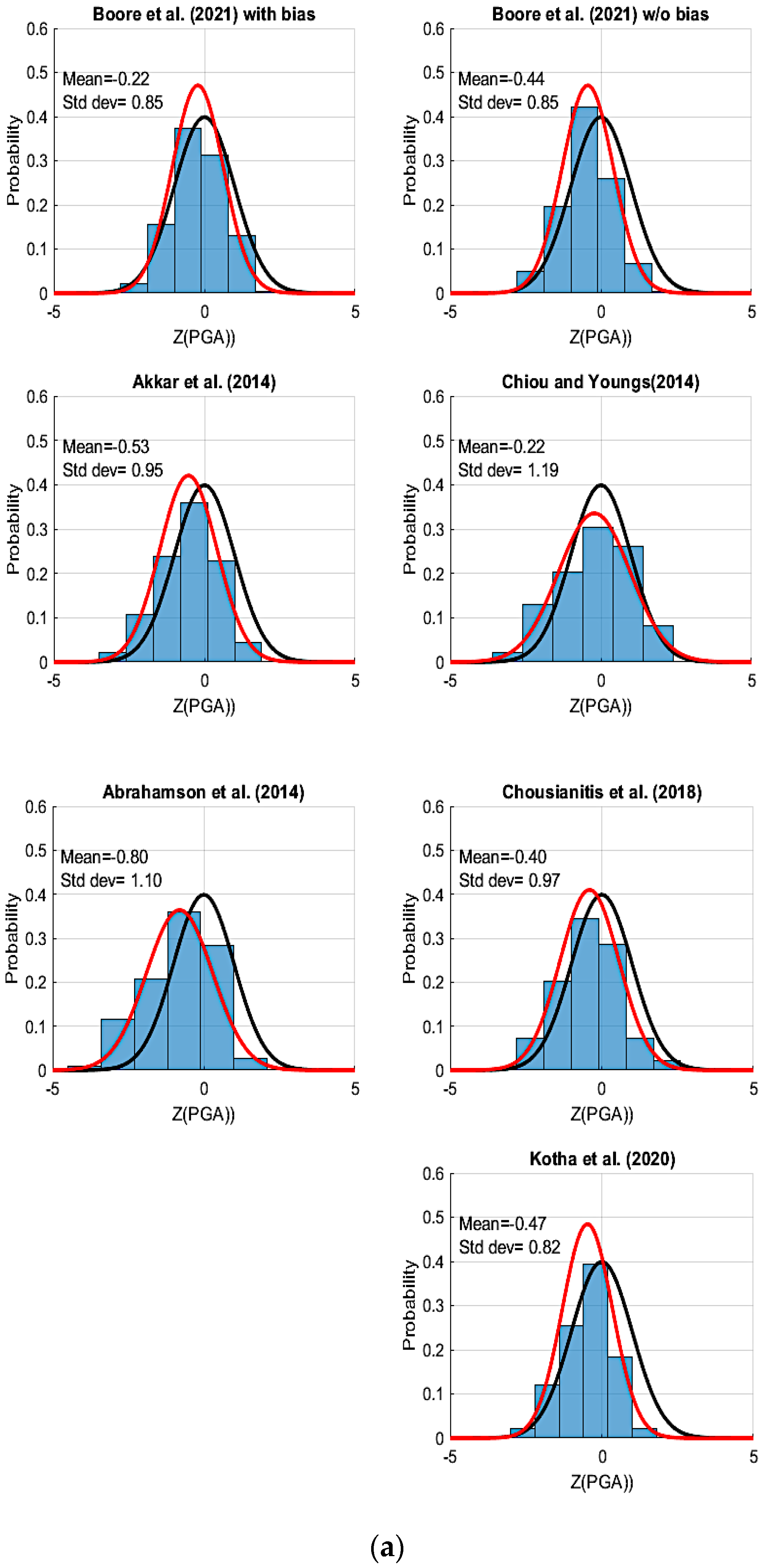
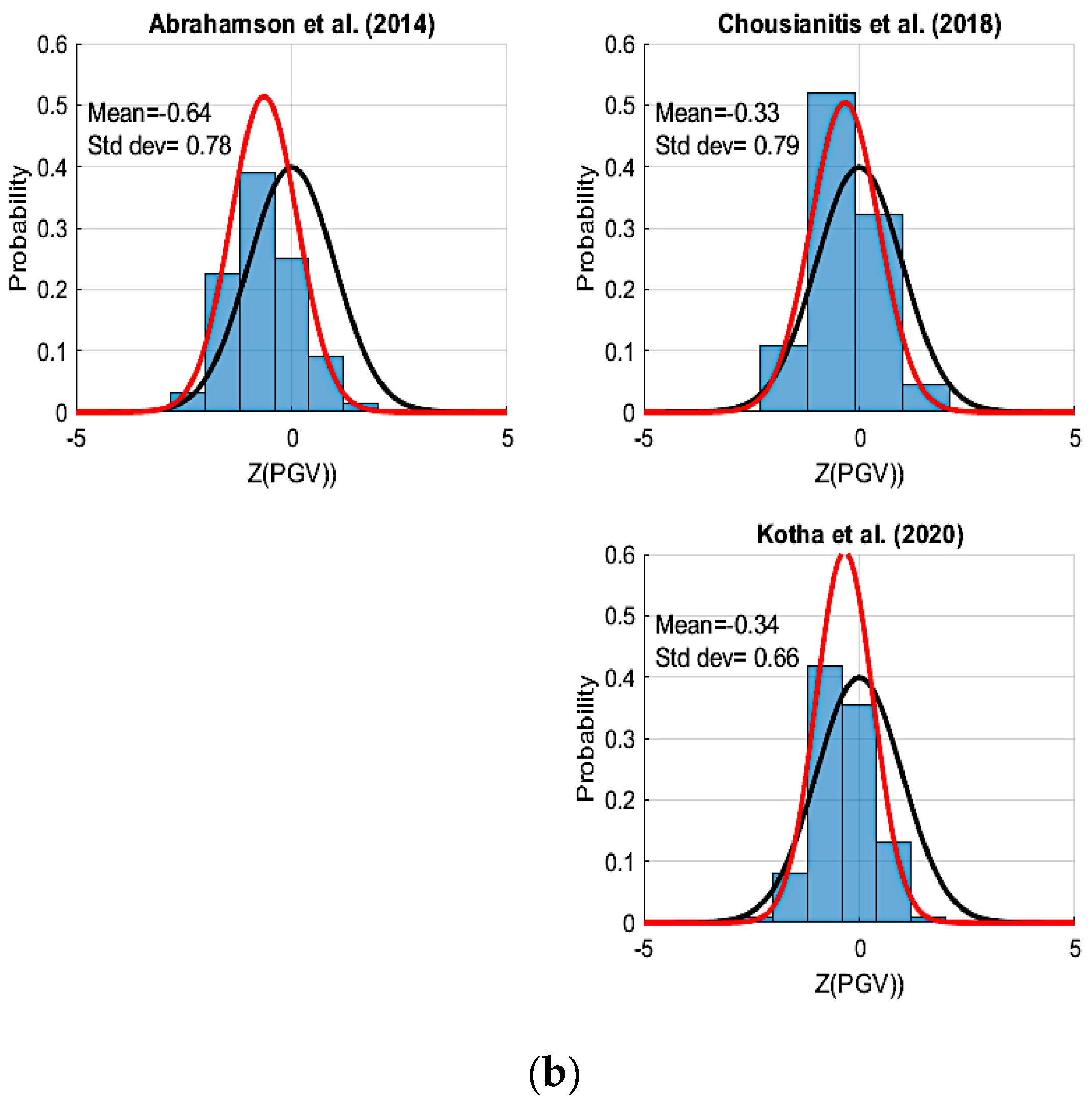
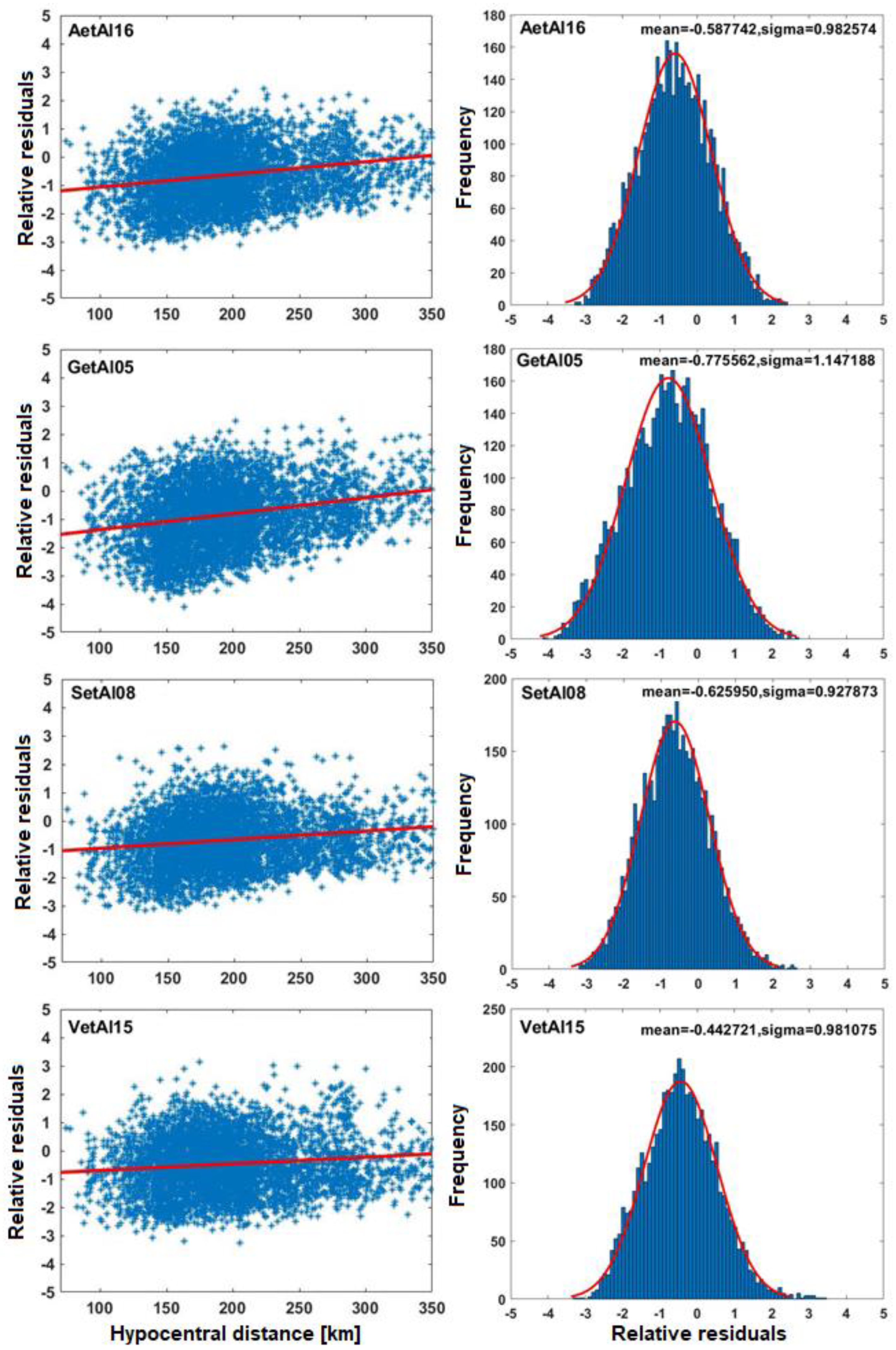
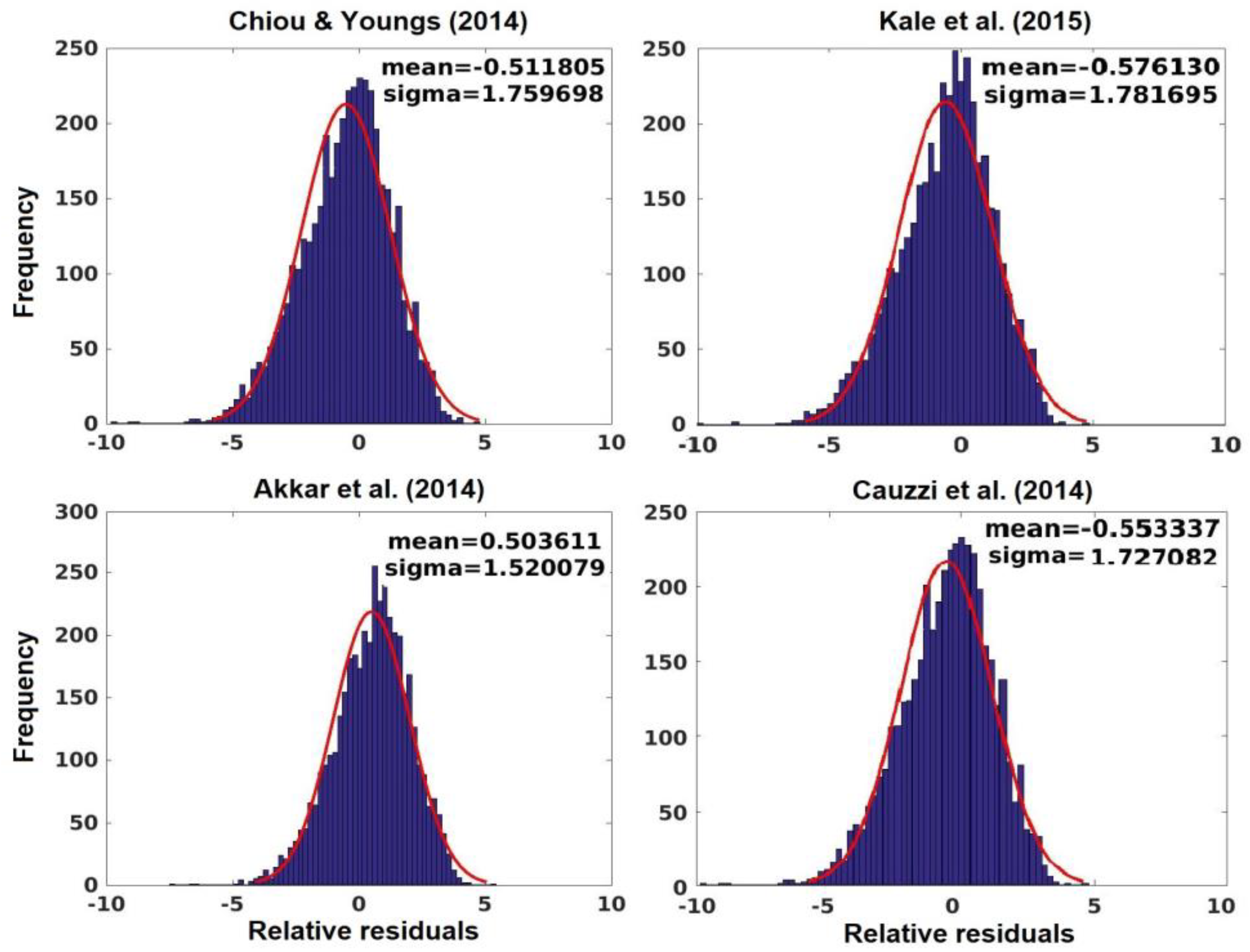
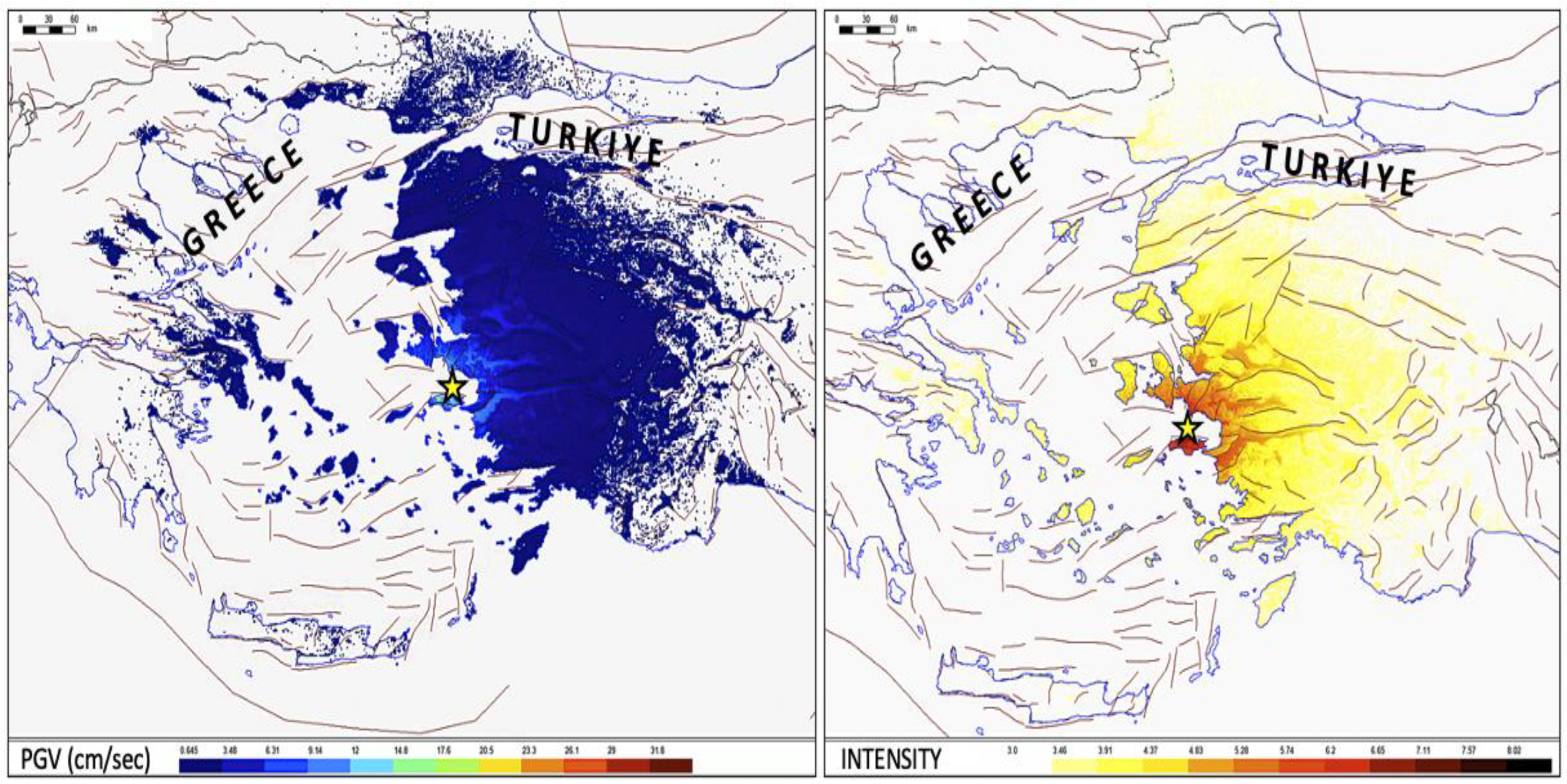
| GMPE | Magnitude Type/Range | Distance Type/Range | Intensity Measure | Site Classification Type | Faulting Style [*] | Horizontal Component Type | Region |
|---|---|---|---|---|---|---|---|
| Akkar et al. (2014) [8] | Mw/4.0–7.6 | Rjb, Rhypo or Repi/1–200 km | PGA, PGV, Sa (T = 0.02–4.0 s) | VS30-based | NS, SS, RS | Geometric Mean | Europe and Middle East |
| Chiou and Youngs (2014) [9] | Mw/3.5–8.5 for SS Mw/3.5–8.5 for NS or RS | Rrup, Rjb,Rx/0–300 km | PGA, PGV, Sa (T = 0.01–10.0 s) | VS30-based (180–1500 m/s) | NS, SS, RS | Arithmetic mean | California, Japan, China, Italy, Turkey |
| Abrahamson et al. (2014) [10] | Mw/3.0–8.5 | Rrup, Rjb, Rx, Ry0/0–300 km | PGA, PGV, Sa (T = 0.01–10.0 s) | VS30-based | NS, SS, RS | Arithmetic mean | California, Japan, China, Taiwan Italy, Turkey |
| Chousianitis et al. (2018) [11] | Mw/4.0–6.8 | Repi/ 0.3–200 km | PGA, PGV, Tm | NEHRP classification (B, C, D) | Unknown, NS, SS, RS | Geometric Mean | Greece |
| Kotha etal. (2020) [12] | Mw/3.0–7.4 | Rjb/1–545 km | PGA, PGV, Sa (T = 0.01–8.0 s) | VS30-based (90–3000 m/s) or slope-based | - | RotD50 | Europe and Mediterranean |
| Boore et al. (2021) with bias [13] | Mw/4.0–8.0 | Rjb/1–300 km | PGA, PGV, Sa (T = 0.01–10.0 s) | VS30-based (150–1200 m/s) | Unknown, NS, SS, RS | RotD50 | Greece |
| Boore et al. (2021) without bias [13] | Mw/4.0–8.0 | Rjb/1–300 km | PGA, PGV, Sa (T = 0.01–10.0 s) | VS30-based (150–1200 m/s) | Unknown, NS, SS, RS | RotD50 | Greece |
| Ranking | GMPE | Mean Norm. Res. (PGA-GV) | Std. Dev. (PGA-PGV) | Z (PGA-PGV) |
|---|---|---|---|---|
| 1 | Boore et al. (2021) [13] with bias | 0.134 | 0.861 | 0.273 |
| 2 | Chiou and Youngs (2014) [9] | −0.230 | 1.082 | 0.313 |
| 3 | Chousianitis et al. (2018) [11] | −0.286 | 0.861 | 0.424 |
| 4 | Akkar et al. (2014) [8] | −0.369 | 0.887 | 0.483 |
| 5 | Boore et al. (2021) [13] w/o bias | −0.562 | 0.932 | 0.630 |
| 6 | Kotha et al. (2020) [12] | −0.407 | 0.749 | 0.658 |
| 7 | Abrahamson et al. (2014) [10] | −0.720 | 0.951 | 0.769 |
| Ranking | GMPE | LLH |
|---|---|---|
| 1 | Chousianitis et al. (2018) [11] | 0.160 |
| 2 | Boore et al. (2021) [13] w/o bias | 0.910 |
| 3 | Boore et al. (2021) [13] w bias | 0.930 |
| 4 | Chiou and Youngs (2014) [9] | 0.932 |
| 5 | Kotha et al. (2020) [12] | 0.971 |
| 6 | Akkar et al. (2014) [8] | 1.035 |
| 7 | Abrahamson et al. (2014) [10] | 1.167 |
| A/A | GMPE | wl-LLH | wl-Residuals | Final wl |
|---|---|---|---|---|
| 1 | Boore et al. (2021) [13] with bias | 0.160 | 0.281 | 0.346 |
| 2 | Chiou and Youngs (2014) [9] | 0.160 | 0.270 | 0.337 |
| 3 | Boore et al. (2021) [13] w/o bias | 0.162 | 0.241 | 0.317 |
| 4 | Chousianitis et al. (2018) [11] | 0.272 | 0.121 | - |
| GMPE | Intensity Measures | Mw Range | Distance Range [km] |
|---|---|---|---|
| Abrahamson et al., 2016 (Aetal16) [40] | PGA, SA (<10 s) | 5–7.9 | <300 |
| Atkinson and Boore 2003 (AB03) [35] | PGA, SA (<4 s) | 5–8.3 | <300 |
| Garcia et al., 2005 (Getal05) [36] | PGA, SA (<5 s), PGV | 5.2–7.4 | <400 |
| Lin and Lee 2008 (LL08) [37] | PGA, SA (<5 s) | 5.3–8.4 | <630 |
| Sokolov et al., 2008 (Setal08) [38] | PGA, SA (<3 s), PGV | 6.3–7.4 | <300 |
| Vacareanu et al., 2015 (Vetal15) [39] | PGA, SA (<3.5 s), PGV | 5.1–8 | <400 |
| GMPE | Intensity Measures | Mw Range | Distance Range [km] |
|---|---|---|---|
| Akkar et al. (2014) [6] | PGA, SA (<4 s) | 4–7.6 | 0–200 |
| Bindi et al. (2014) [41] | PGA, SA (<3 s) | 4–7.6 | 0–300 |
| Boore et al. (2014) [42] | PGA, SA (<10 s) | 3–7.9 | 0–400 |
| Cauzzi et al. (2014) [43] | PGA, SA (<10 s) | 4.5–7.9 | 0–150 |
| Chiou and Youngs (2014) [7] | PGA, SA (<10 s) | 3.5–8.5 | 0–300 |
| Kale et al. (2015) [44] | PGA, SA (≤4 s) | 4–8 | 0–200 |
| GMPE | PGA | PGV | Final Weights | ||
|---|---|---|---|---|---|
| LH | LLH | LH | LLH | ||
| Abrahamson et al. (2016) [40] | 0.38 | 0.71 | * | * | - |
| Atkinson and Boore. (2003) [35] | 0.44 | −0.25 | * | * | - |
| Garcia et al. (2005) [36] | 0.33 | 0.83 | 0.3 | 0.72 | 0.308 |
| Lin and Lee (2008) [37] | 0.22 | 1.14 | * | * | - |
| Sokolov et al. (2008) [38] | 0.4 | 0.67 | 0.38 | 0.53 | 0.314 |
| Vacareanu et al. (2015) [39] | 0.45 | 0.47 | 0.26 | 1.06 | 0.378 |
| GMPE | PGA | PGV | Final Weights | ||
|---|---|---|---|---|---|
| LH | LLH | LH | LLH | ||
| Akkar et al. (2014) [6] | 0.38 | −0.39 | 0.49 | 0.13 | - |
| Bindi et al. (2014) [41] | 0.32 | −0.85 | 0.49 | −0.33 | - |
| Boore et al. (2014) [42] | 0.30 | −0.86 | 0.50 | −0.19 | 0.214 |
| Cauzzi et al. (2014) [43] | 0.41 | −0.29 | 0.28 | 0.96 | 0.297 |
| Chiou and Youngs (2014) [7] | 0.33 | −0.38 | 0.42 | 0.03 | 0.222 |
| Kale et al. (2015) [44] | 0.44 | −0.47 | 0.49 | 0.22 | 0.267 |
Disclaimer/Publisher’s Note: The statements, opinions and data contained in all publications are solely those of the individual author(s) and contributor(s) and not of MDPI and/or the editor(s). MDPI and/or the editor(s) disclaim responsibility for any injury to people or property resulting from any ideas, methods, instructions or products referred to in the content. |
© 2024 by the authors. Licensee MDPI, Basel, Switzerland. This article is an open access article distributed under the terms and conditions of the Creative Commons Attribution (CC BY) license (https://creativecommons.org/licenses/by/4.0/).
Share and Cite
Theodoulidis, N.; Margaris, B.; Sotiriadis, D.; Zulfikar, C.; Okuyan Akcan, S.; Cioflan, C.O.; Manea, E.F.; Toma-Danila, D. Rapid Earthquake Damage Assessment System in the Black Sea Basin: Selection/Adoption of Ground Motion Prediction Equations with Emphasis in the Cross-Border Areas. GeoHazards 2024, 5, 255-270. https://doi.org/10.3390/geohazards5010013
Theodoulidis N, Margaris B, Sotiriadis D, Zulfikar C, Okuyan Akcan S, Cioflan CO, Manea EF, Toma-Danila D. Rapid Earthquake Damage Assessment System in the Black Sea Basin: Selection/Adoption of Ground Motion Prediction Equations with Emphasis in the Cross-Border Areas. GeoHazards. 2024; 5(1):255-270. https://doi.org/10.3390/geohazards5010013
Chicago/Turabian StyleTheodoulidis, Nikolaos, Basil Margaris, Dimitris Sotiriadis, Can Zulfikar, Seyhan Okuyan Akcan, Carmen Ortanza Cioflan, Elena Florinela Manea, and Dragos Toma-Danila. 2024. "Rapid Earthquake Damage Assessment System in the Black Sea Basin: Selection/Adoption of Ground Motion Prediction Equations with Emphasis in the Cross-Border Areas" GeoHazards 5, no. 1: 255-270. https://doi.org/10.3390/geohazards5010013







